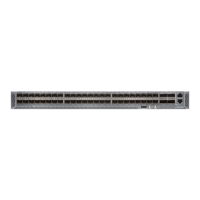The optical interface to et mapping is displayed in the following table:
Mapped et interface(s)Modulation FormatPort Numberot- interface
et-0/2/0QPSK-100GPort 38ot-0/2/0
et-0/2/0
et-0/2/1
8QAM-200G
et-0/2/0
et-0/2/1
16QAM-200G
et-0/2/2QPSK-100GPort 39ot-0/2/1
et-0/2/2
et-0/2/3
8QAM-200G
et-0/2/2
et-0/2/3
16QAM-200G
Default Port Configuration on ACX5448-D
By default (factory-default configuration), when you power on an ACX5448-D router, the following port
combinations are available:
•
36 SFP+ ports (ports 0 through 35)—These ports can operate as native 10-Gigabit Ethernet interfaces
or as 1-Gigabit Ethernet interfaces when you use 1-gigabit optics.
•
Two QSFP28 ports (36 and 37)—The interface for port 36 is not created. However, you can configure
port 37 as native 100-Gigabit or 40-Gigabit Ethernet interfaces, or channelize these ports into four
25-Gigabit Ethernet or 10-Gigabit Ethernet interfaces, respectively, by using CLI configuration and
breakout cables.
•
Two CFP2 ports (38 and 39)—You can configure each of the CFP2 ports as a 200-Gigabit Ethernet port.
Multiplexing on ACX5448-D Routers
As we have seen in the preceding sections, the et-0/1/0 interface is created for QSFP28 port 36 and the
ot-0/2/0 interface is created for CFP2 port 38. The ot-0/2/0 interface is mapped to the et- interfaces
et-0/2/0 and et-0/2/1.
The QSFP28 port 36 (interface et-0/1/0) and the CFP2 port 38 (interface et-0/2/1) operate as multiplexer
(also called mux) ports.
34

